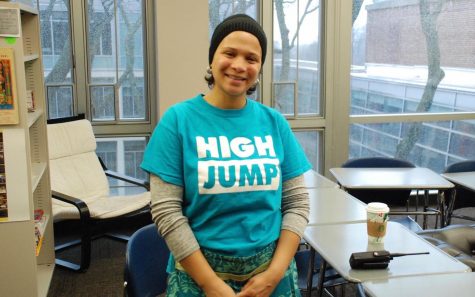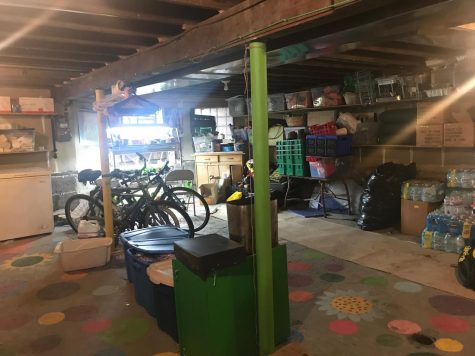A Day At Green City
Lincoln Park’s Farmers Market
After traveling in Europe and being blown away by the food from its markets, Chef Abby Mandel realized the importance of bringing high quality, fresh produce back to Chicago. She pitched her idea to any farmer who would listen, found a space in an alley behind the Chicago Theater in the Loop, and orchestrated her first of many Green City farmers’ markets with six vendors in the spring of 1998.
19 years later, as early as 6:00 am on May 5, farmers begin propping up white tents on the grassy stretch between Clark and Stockton Drive, just four blocks south of Parker. While arranging their fresh-cut flowers, jams, and tomatoes for display, they catch up with their “neighbors” before they’ll be too busy–after all, many haven’t seen each other since fall.
By 6:45, the preparation is done. The vendors are ready, most having years of experience to nail down the assembly of their booths, and visitors start trickling in, kicking off Green City Market’s outdoor season at 7:00.
This year marks the tenth anniversary since Mandel’s death. Since its humble beginning, Green City has evolved into Chicago’s largest farmers’ market, keeping its founder’s vision alive.
The Lincoln Park location, which opened in 2002, operates every Wednesday and Saturday from May to October, with an indoor market at the Peggy Notebaert Nature Museum during the winter. Green City has expanded to hold a Saturday outdoor market in the West Loop, and a Thursday one at Gallagher Way, next to Wrigley Field.
Over the course of the next six hours, more than 40 different teams of farmers, chefs, family, and friends sell fruit, vegetables, baked goods, and dairy products to customers who range from families with young kids to seniors to Parker science teacher John Paul Iaconianni, a regular. Visitors stroll the aisles between booths and picnic in the adjacent open area, while a band called The Winchesters livens the atmosphere with folk-rock songs on the sunny day.
“This is by far the nicest opening day, and I’ve been doing this for 10, maybe 15, years,” Troy Ong, an owner of Garden Offerings & Petals Farm, said. “The perfect weather, a great crowd.” The tall Huntley resident, dressed in a gray Nike tee, explains that his mother-in-law started growing flowers 25 years ago, and the project developed into the family-run farm that it is now.
On Ong’s table, there are a handful of bouquets–his assorted orange, red, and yellow tulips have proven to be popular. By 10:45, he’s nearly sold out.
“I’d be lying if I said part of the reason I love Green City isn’t the experience,” Iaconianni said. “It’s great being outside, walking around with a bunch of people, and I take my dog, too. Also, the selection is impressively varied and with hard-to-find goods you wouldn’t necessarily see in a standard food store. I don’t go in planning what to get–I sort of buy it and and then figure out what I want to make with it after the fact. ”
At 11:00, Chef Paul Virant, of Hinsdale restaurant Vie and Vistro, is close to finishing up his ramp green salsa demonstration for a 40-person crowd in the center of the Market. As his slices, he explains that ramps, a species of wild onion, originated in the Appalachians but was also prevalent here, and that’s why the city was named Chicago–it literally translates to “stinky onion” in Algonquian. Beside Virant, his middle school age son, Zane, zests a lemon.
When the salsa’s done, Virant’s audience–about half seated in white plastic chairs, the rest standing in the back–clumps around his station to taste a sample.
The chef demos are a part of Green City’s larger education initiative, which is largely targeted to youth. Green City facilitates a Club Sprouts program at each market, which provides kids the opportunity to try in-season market items, engage in food-themed arts and crafts, and make recipes using fresh ingredients. Since 2005, it’s helped run the Edible Gardens at the Lincoln Park Zoo, a 5,000 square foot vegetable garden where adults and children alike can gain hands-on farming experience, and it teaches cooking and gardening courses at the Manierre Elementary School and DePaul College Prep.
“We know that it is really important to get students and children to understand and be connected to their food,” Green City’s Executive Director Melissa Flynn said. “Not only do they eat healthier, but then they have a greater knowledge of how to nourish themselves moving forward. We need to raise the next generation of eaters who care about sustainable food.”
Sustainability–as Flynn puts it, “leaving the land better than you found it”–is central to the Market’s mission. All vendors are required by Green City to be certified by an outside organization that recognizes farms for earth-responsible practices, like humane treatment of animals and environmental stewardship. According to Flynn, Green City is different from other farmers’ markets in its priority of sustainability.
Quest’s values align closely with Green City’s, and Parker even orders apples and other produce from Market vendor Seedling Farm, based in South Haven, Michigan. “Sustainability is important to us because we’re such a large student body, and our carbon footprint is pretty massive,” Executive Chef Zac Maness said. “As much as we can cut down on that, the better off we’ll all be.”
Craig Siegelin, who owns Hoosier Mama Pie Company with his wife, Paula Haney, and has been a vendor at the Market since 2007, appreciates its emphasis on sustainability. “Green City Market has connected us with farmers and helped us communicate our goals to people because their mission goes with ours so well,” Siegelin said, referencing his commitment to using local ingredients. “It’s been great having relationships with other farmers. We see them every week.”
To make their pies, the Hoosier Mama duo buy fruit from Ellis Farms and Seedling, and vegetables from Leaning Shed and Green Acres, other Green City vendors. At 11:30, Siegelin describes to a customer the distinct tastes of his peach, maple pecan, and apple honey dried cherry flavors.
Food typically travels 1500+ miles to get to a grocery store. On the other hand, produce travels 150 miles or less, on average, to get to a Green City Market. This map shows where Green City’s vendors are based, color-coded by type.Sophomore Iz Brouzis, who’s visited Green City frequently with her mom over the past few years, appreciates the farmer-to-buyer interaction. “It’s nice to go to the market and know the farmer and the farm that your produce comes from,” Bruozis said, “rather than going to a grocery store and thinking, ‘I don’t know where anything’s from.’”
“The power of food to unite people is amazing,” Flynn said. “It is more than just a market. It’s an opportunity to learn, to nourish yourself, but it’s an opportunity to gather as a community.”
For the last few years, the annual ninth grade trip to Green City on a Wednesday in late May or June has served as a bonding experience for the class. “We go, and the kids get to see natural produce and enjoy a treat, and it’s a celebration of how far they’ve come after a year in the high school,” Freshman Gradehead Cory Zeller said. “Some people get flowers, some people get baked goods. In walking over there, in poking around, in sitting down on the lawn, or playing music with the guy who brings instruments there, there’s something for everyone.”
At 12:45, as closing time draws near, Tracy Vowell, of Three Sisters Farms from Kankakee, IL, debriefs the day with one of her “neighbors,” Debbie Dorfman, a Chicagoan who helps out at the Ellis Farms stand.
“We like just being silly,” Dorfman said. “Sometime we giggle about how food-ignorant people are–it’s really interesting and sad at the same time how people don’t realize that things have seasons, or how plants grow. We try to change that here. A big part of the interactions is also getting to know who people are and what they do in the off-season because not all the farmers are only farmers–for example, Tracy’s also an artist.”
By 1:15, vendors have started to disassemble their booths. Matt Hoffman, from Matt’s Urban Garden, moves his pots of flowers from display to rack. A volunteer from Lakeview Pantry approaches him, introducing herself as the “Lakeview Pantry Girl,” and hands him a cardboard box.
According to Flynn, Green City vendors donate unsold goods to the Panty at the end of each market day and last year together contributed over $50,000 worth.
As Hoffman places leafy green plants in the box, the Lakeview Pantry Girl compliments them. He fills it, and before she walks away, he tells her, “See you next week.”











